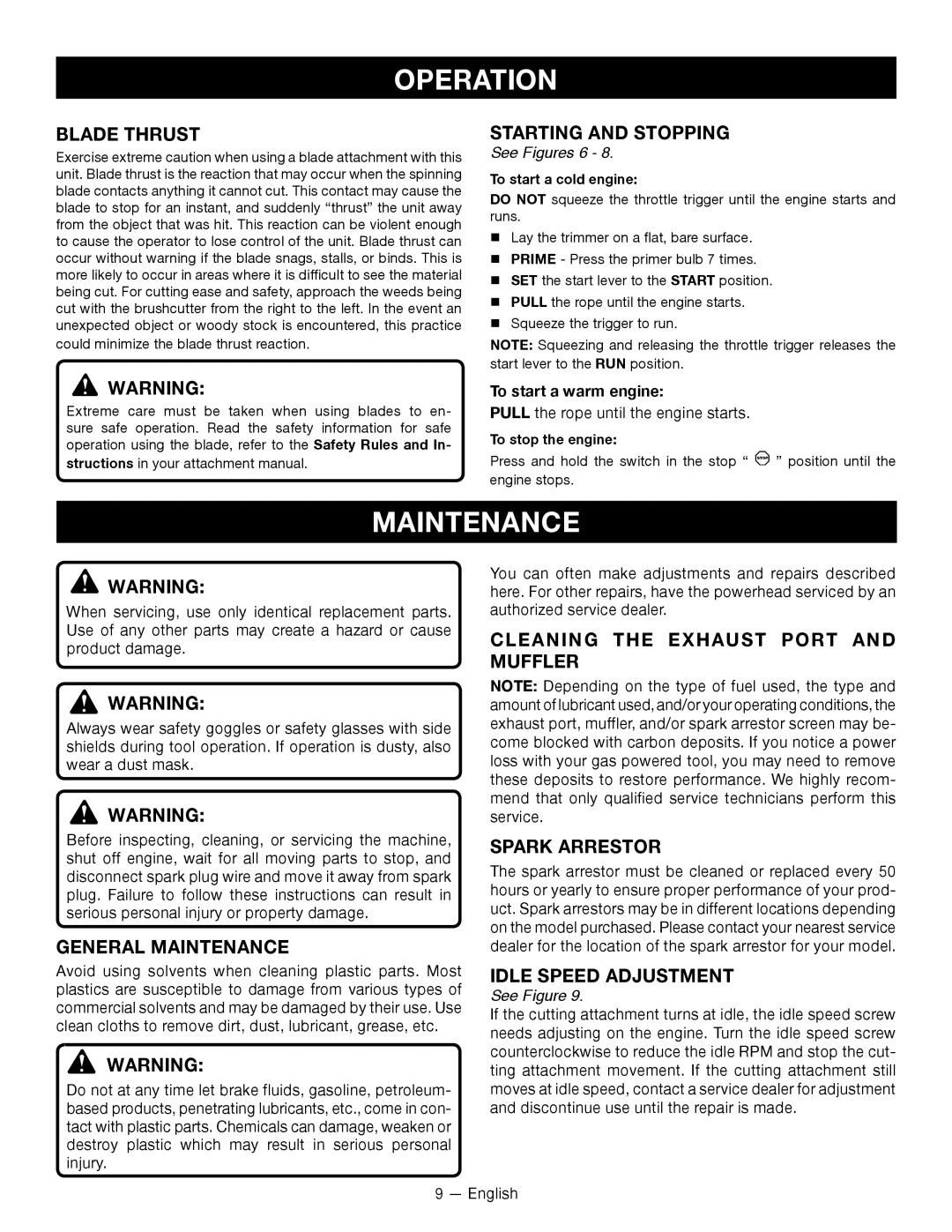
OPERATION
BLADE THRUST
Exercise extreme caution when using a blade attachment with this unit. Blade thrust is the reaction that may occur when the spinning blade contacts anything it cannot cut. This contact may cause the blade to stop for an instant, and suddenly “thrust” the unit away from the object that was hit. This reaction can be violent enough to cause the operator to lose control of the unit. Blade thrust can occur without warning if the blade snags, stalls, or binds. This is more likely to occur in areas where it is difficult to see the material being cut. For cutting ease and safety, approach the weeds being cut with the brushcutter from the right to the left. In the event an unexpected object or woody stock is encountered, this practice
could minimize the blade thrust reaction.
WARNING:
Extreme care must be taken when using blades to en- sure safe operation. Read the safety information for safe operation using the blade, refer to the Safety Rules and In-
structions in your attachment manual.
STARTING AND STOPPING
See Figures 6 - 8.
To start a cold engine:
DO NOT squeeze the throttle trigger until the engine starts and runs.
Lay the trimmer on a flat, bare surface.
PRIME - Press the primer bulb 7 times.
SET the start lever to the START position.
PULL the rope until the engine starts.
Squeeze the trigger to run.
NOTE: Squeezing and releasing the throttle trigger releases the start lever to the RUN position.
To start a warm engine:
PULL the rope until the engine starts.
To stop the engine:
Press and hold the switch in the stop “ ![]() ” position until the engine stops.
” position until the engine stops.
MAINTENANCE
![]() WARNING:
WARNING:
When servicing, use only identical replacement parts. Use of any other parts may create a hazard or cause product damage.
WARNING:
Always wear safety goggles or safety glasses with side shields during tool operation. If operation is dusty, also wear a dust mask.
WARNING:
Before inspecting, cleaning, or servicing the machine, shut off engine, wait for all moving parts to stop, and disconnect spark plug wire and move it away from spark plug. Failure to follow these instructions can result in serious personal injury or property damage.
GENERAL MAINTENANCE
Avoid using solvents when cleaning plastic parts. Most plastics are susceptible to damage from various types of commercial solvents and may be damaged by their use. Use clean cloths to remove dirt, dust, lubricant, grease, etc.
WARNING:
Do not at any time let brake fluids, gasoline, petroleum- based products, penetrating lubricants, etc., come in con- tact with plastic parts. Chemicals can damage, weaken or destroy plastic which may result in serious personal injury.
You can often make adjustments and repairs described here. For other repairs, have the powerhead serviced by an authorized service dealer.
CLEANING THE EXHAUST PORT AND MUFFLER
NOTE: Depending on the type of fuel used, the type and amount of lubricant used, and/or your operating conditions, the exhaust port, muffler, and/or spark arrestor screen may be- come blocked with carbon deposits. If you notice a power loss with your gas powered tool, you may need to remove these deposits to restore performance. We highly recom- mend that only qualified service technicians perform this service.
SPARK ARRESTOR
The spark arrestor must be cleaned or replaced every 50 hours or yearly to ensure proper performance of your prod- uct. Spark arrestors may be in different locations depending on the model purchased. Please contact your nearest service dealer for the location of the spark arrestor for your model.
Idle Speed Adjustment
See Figure 9.
If the cutting attachment turns at idle, the idle speed screw needs adjusting on the engine. Turn the idle speed screw counterclockwise to reduce the idle RPM and stop the cut- ting attachment movement. If the cutting attachment still moves at idle speed, contact a service dealer for adjustment and discontinue use until the repair is made.
9 — English
